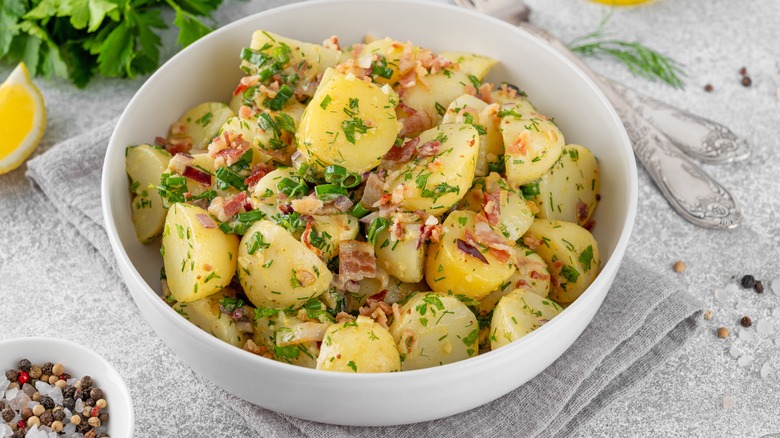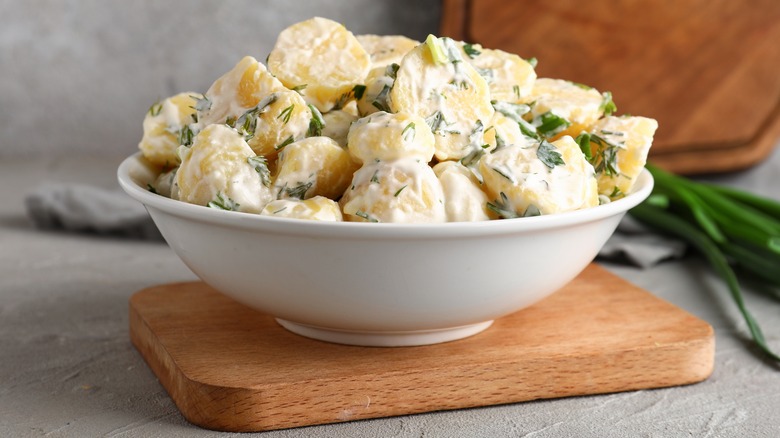Bobby Flay's Dressing Tip For Ultra-Flavorful Potato Salad
No grill session or cookout is complete without some creamy, tender, and tangy homemade potato salad to accompany the smoky meats, fish, and vegetables. And the simple side is so easy to elevate. If you want to pack extra flavor into yours, then Bobby Flay has the perfect method to transform the taste of the tubers every time: Dress the potatoes while they're warm, not cold.
The reason that the temperature matters for potato salad comes down to how efficiently the spuds absorb the dressing — and therefore all the additional flavors that come with it, too. As the boiled and drained spuds begin to cool down, their surface becomes harder thanks to the starchy coating. This makes it more difficult for the dressing to permeate through the outside. Also, the potatoes shrink a little, and the texture becomes tighter as they cool, which makes it even less likely that the flavorful dressing can get to the inside.
Essentially, the heat makes it "much easier for the dressing to become part of the potatoes," Flay explains — whereas if the tubers are cold, they "actually repel the dressing" (via YouTube). So if you want the potatoes and dressing to seamlessly meld together in your next salad, just follow the chef's advice for the best results.
Bobby Flay adds the dressing to warm potatoes
Bobby Flay doesn't just use hot potatoes to amplify the flavors in his potato salad; the actual dressing is hot, too. The chef and TV personality likes to use a vinaigrette-style dressing, mixed and heated in a saute pan, rather than a classic mayo-laden basic potato salad recipe. Using deliciously savory bacon grease to fry the onions gives it another layer of rich flavor while cider vinegar and Dijon mustard ramp up the sweet-sharp notes.
A top tip to keep the potatoes warm while you finish the dressing is to place them in a large bowl and cover them. Once you've combined your potatoes and dressing, it's worth saving any delicate fresh herbs you want to add to the potato salad until the whole thing has cooled, otherwise the heat could cause them to wilt. Stirring through the parsley, chives, dill, or whichever soft herb you're using once the temperature is lower will result in a more visually appetizing dish, with brighter color and better texture.
There are many different types of potato salad, and it's worth noting that while oil-based dressings such as Flay's respond especially well to hot potatoes, you'll want to avoid this technique with mayo-based dressings. This is because the heat can cause the mayonnaise to break. So for creamier-style salads, allow the tubers to cool down for around half an hour before dressing to minimize any risk of an oily mess.
More tips for the most flavorful potato salad
Achieving the maximum amount of flavor in potato salads begins before you dress them. You also need to flavor the water that the potatoes cook in for the tastiest tubers. Bobby Flay likes to add chunks of onion to his potato water to enhance the taste, but you could also use garlic, herbs, or vinegar in addition to salt and pepper. Just as the hot dressing absorbs better into the potatoes, seasoned water will also penetrate for a tastier spud right through to the center of each bite.
Switching up the dressing is another way to incorporate bolder flavors. Make a potato salad with horseradish and other punchy ingredients such as salty anchovies to ramp up the umami notes; you can brighten the dish with a squeeze of zingy lemon. Or try whisking mayo with sour cream, sriracha, honey, and the juice and zest of a lime for a tangy, spicy dressing that would go perfectly with grilled chicken. To increase the heat, add some chili flakes.
To really take the dish to the next level, consider more unusual ingredients for a new spin. For example, Ina Garten's French potato salad trades mayo for a boozy substitute, replacing a creamy dressing with one packed with fresh green herbs, mustardy vinaigrette, and a splash of white wine. Or add fragrant dill, lemon, and saffron to potato salad for an elegant and aromatic accompaniment to fish or seafood.



